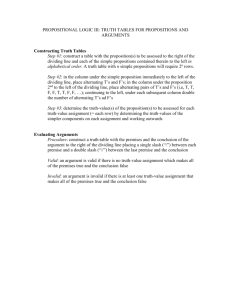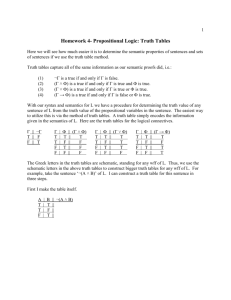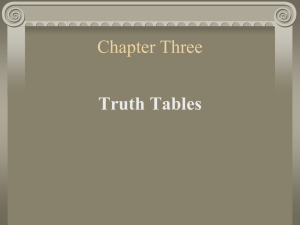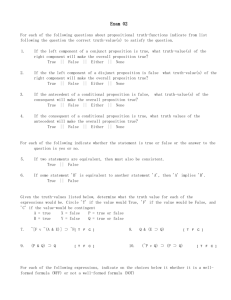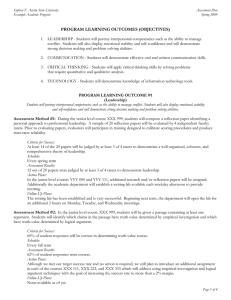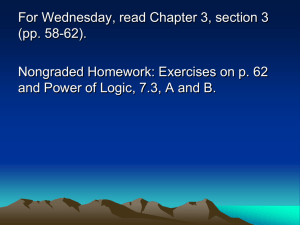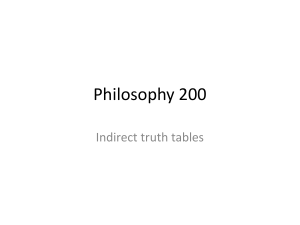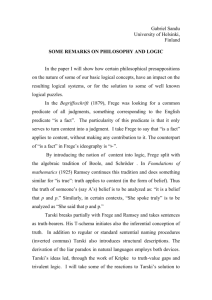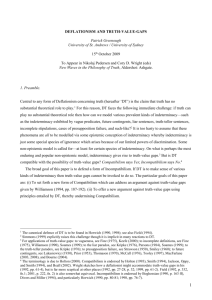3.4E 4c
advertisement
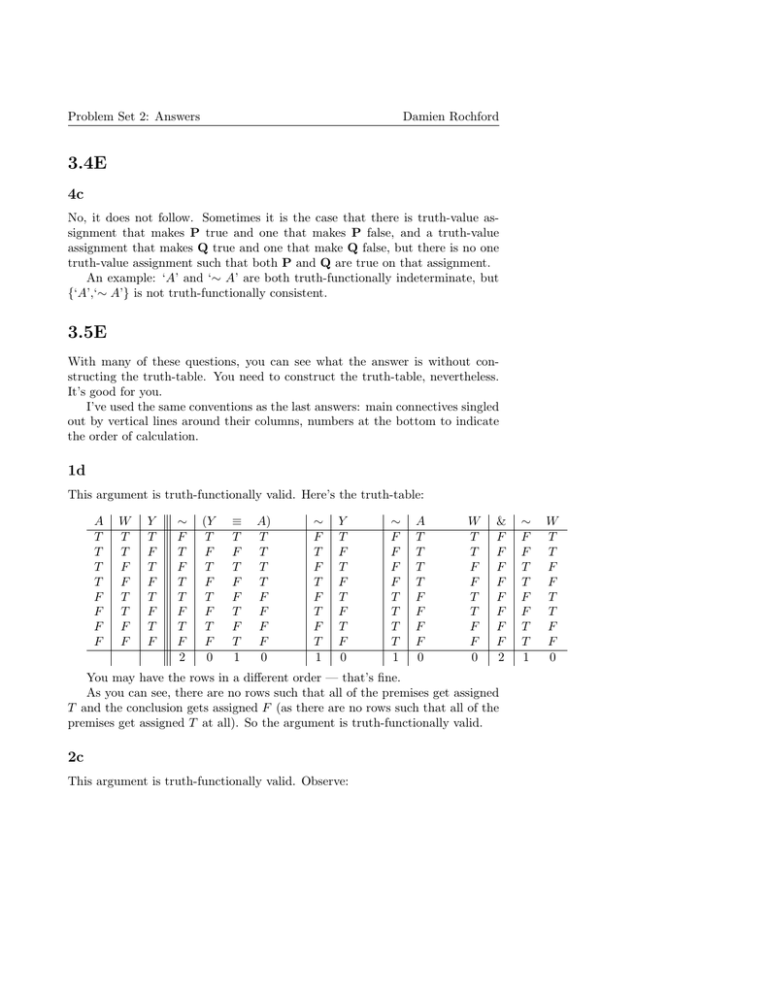
Problem Set 2: Answers
Damien Rochford
3.4E
4c
No, it does not follow. Sometimes it is the case that there is truth-value as­
signment that makes P true and one that makes P false, and a truth-value
assignment that makes Q true and one that make Q false, but there is no one
truth-value assignment such that both P and Q are true on that assignment.
An example: ‘A’ and ‘∼ A’ are both truth-functionally indeterminate, but
{‘A’,‘∼ A’} is not truth-functionally consistent.
3.5E
With many of these questions, you can see what the answer is without con­
structing the truth-table. You need to construct the truth-table, nevertheless.
It’s good for you.
I’ve used the same conventions as the last answers: main connectives singled
out by vertical lines around their columns, numbers at the bottom to indicate
the order of calculation.
1d
This argument is truth-functionally valid. Here’s the truth-table:
A
T
T
T
T
F
F
F
F
W
T
T
F
F
T
T
F
F
Y
T
F
T
F
T
F
T
F
∼
F
T
F
T
T
F
T
F
2
(Y
T
F
T
F
T
F
T
F
0
≡
T
F
T
F
F
T
F
T
1
A)
T
T
T
T
F
F
F
F
0
∼
F
T
F
T
F
T
F
T
1
Y
T
F
T
F
T
F
T
F
0
∼
F
F
F
F
T
T
T
T
1
A
T
T
T
T
F
F
F
F
0
W
T
T
F
F
T
T
F
F
0
&
F
F
F
F
F
F
F
F
2
You may have the rows in a different order — that’s fine.
As you can see, there are no rows such that all of the premises get assigned
T and the conclusion gets assigned F (as there are no rows such that all of the
premises get assigned T at all). So the argument is truth-functionally valid.
2c
This argument is truth-functionally valid. Observe:
∼
F
F
T
T
F
F
T
T
1
W
T
T
F
F
T
T
F
F
0
A
T
T
F
F
B
T
F
T
F
A
T
T
F
F
0
⊃
F
F
T
T
2
∼
F
F
T
T
1
A
T
T
F
F
0
(B
T
F
T
F
0
⊃
T
T
F
T
1
A)
T
T
F
F
0
⊃
T
F
T
F
2
B
T
F
T
F
0
A
T
T
F
F
0
≡
F
T
T
F
2
∼
F
T
F
T
1
B
T
F
T
F
0
There is one row that assigns both premises true: the �F, T � row (marked out
by horizontal lines). As you can see, that row assigns T to the conclusion. So
there are no rows such that all of the premises get assigned T and the conclusion
gets assigned F . So the argument is truth-functionally valid.
2d
Ergh — one of the sentence letters is a ‘T’. Don’t confuse the sentence letter
‘T’ with the truth-value ‘T’ below.
This argument is truth-functionally invalid. Here is a shortened truth-table
that shows that.
J
T
M
T
T
T
J
T
0
∨
T
3
[M
T
0
⊃
T
2
(T
T
0
≡
T
1
J)]
T
0
(M
T
0
⊃
T
1
J)
T
0
&
T
2
⊃
T
1
(T
T
0
M)
T
0
T
T
0
&
F
2
∼
F
1
M
T
0
4f
Let A = ‘The butler murdered Devon’; B = ‘The maid is lying’; C = ‘The
gardener murdered Devon’; D = ‘The weapon was a slingshot’.
The argument:
(A ⊃ B)&(C ⊃ D)
(B ≡ ∼ D)&(∼ D ⊃ A)
A
This argument is not truth-functionally valid. Check it out:
A
F
B
F
C
T
D
T
(A
F
0
⊃
T
1
B)
F
0
&
T
2
(C
T
0
⊃
T
1
D)
T
0
(B
F
0
≡
T
2
∼
F
1
D)
T
0
5c
No, it does not follow. Here is a counterexample. Let P=A ∨ B, Q=A, R=B.
{‘A ∨ B � } truth-funcitonally entails A ∨ B, obviously. {‘A ∨ B � } does not
truth-functionally entail A (consider A false, B true), and it does not truthfunctionally entail B (consider A true, B false).
2
&
T
3
(∼
F
1
D
T
0
⊃
T
2
A)
F
0
A
F
3.6E
Throughout this section, when I say something like ‘there is no truth-value
assignment such that’ blah, what I mean is ‘there is no truth-value assignment
such that, on that assignment’ blah.
2b
Γ |= �P ⊃ Q� iff there is no truth-value assignment such that every member of Γ
is true and �P ⊃ Q� is false. There is no truth-value assignment such that every
member of Γ is true and �P ⊃ Q� is false iff there is no truth-value assignment
such that every member of Γ is true, P is true and Q is false (by the definition
of ‘⊃’). There is no truth-value assignment such that every member of Γ is true,
P is true and Q is false iff there is no truth-value assignment such that every
member of Γ ∪ {P} is true and Q is false. There is no truth-value assignment
such that every member of Γ ∪ {P} is true and Q is false iff Γ ∪ {P} |= Q.
Therefore, Γ |= �P ⊃ Q� iff Γ ∪ {P} |= Q.
Q.E.D.
3b
Suppose Γ |= P and Γ |= �∼ P�. Then
(1) there is no truth-value assignment such that every member of Γ is true and
P is false, and
(2) there is no truth-value assignment such that every member of Γ is true and
∼ P is false.
By (2) (and the definition of ‘∼’), there is no truth-value assignment such that
every member of Γ is true and P is true. From this and (1) it follows that there
is no truth-value assignment such that every member of Γ is true and P is true
and there is no truth-value assignment such that every member of Γ is true and
P is false. But if there is any truth-value assignment such that every member
of Γ is true, it is either such that every member of Γ is true and P is true or it
is such that every member of Γ is true and P is false. So there is no truth-value
assignment such that every member of Γ is true. So Γ is truth-functionally
inconsistent.
So if Γ |= P and Γ |= �∼ P�, then Γ is truth-functionally inconsistent.
Q.E.D.
4a
Suppose {P} |= Q, and {�∼ P�} |= R. Then
(1) there is no truth-value assignment such that P is true and Q is false, and
(2) there is no truth-value assignment such that ∼ P is true and R is false.
3
By (2) (and the definition of ‘∼’),
(3) there is no truth value assignment such that P is false and R is false.
Now, every truth-value assignment is either such that Q is true or such that
Q is false. So, by (1),
(4) if a truth-value assignment is such that P is true, it is such that Q is true.
And every truth-value assignment is either such that R is true or is such that
R is false. So, by (3)
(5) if a truth-value assignment is such that P is false, then it is such that R is
true.
But every truth-value assignment is either such that P is true or such that
P is false. So, by (4) and (5), every truth-value assignment is either such that
Q is true or such that R is true. So (by the definition of ‘∨’), every truth-value
assignment is such that �Q ∨ R� is true. So �Q ∨ R� is truth-functionally true.
So if {P} |= Q, and {�∼ P�} |= R, then �Q ∨ R� is truth-functionally true.
Q.E.D.
4c
Suppose Γ |= P and Γ� |= Q. Then
(1) there is no truth-value assignment such that every member of Γ is true and
P is false, and
(2) there is no truth value assignment such that every member of Γ� is true and
Q is false.
By (1), there is no truth-value assignment such that every member of Γ ∪ Γ� is
true and P is false. And by (2), there is no truth-value assignment such that
every member of Γ ∪ Γ� is true and Q is false. So (by the definition of ‘&’) there
is no truth-value assignment such that Γ ∪ Γ� is true and �P&Q� is false. So
Γ ∪ Γ� |= �P&Q�.
So, if Γ |= P and Γ� |= Q, then Γ ∪ Γ� |= �P&Q�.
Q.E.D.
4
MIT OpenCourseWare
http://ocw.mit.edu
24.241 Logic I
Fall 2009 For information about citing these materials or our Terms of Use, visit: http://ocw.mit.edu/terms.
